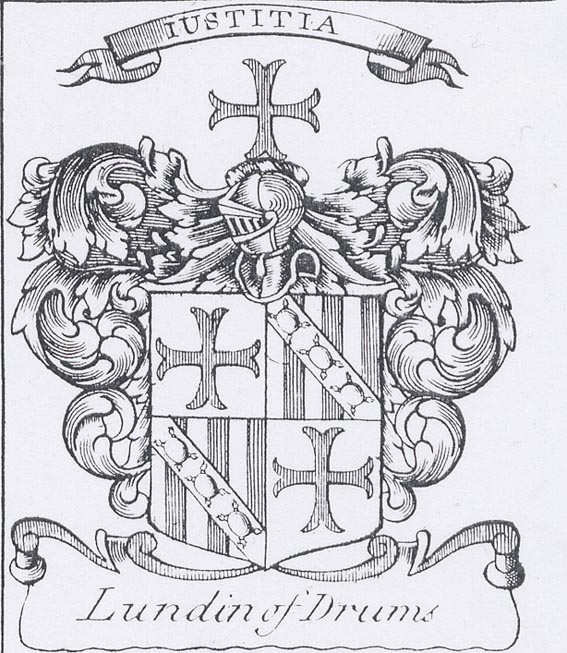|
History
After the main line of the
family Lundie of Balgonie failed, the heirs of line of this family became
the Lundinís of Drum. There were no lands for them to inherit, as the Barony
of Balgonie had been sold by 1640, so the designation as Ďof Drumsí was
maintained. However the Lundieís of drums (becoming Lundinís of Drums) carry
the Arms of the Lundie family of Balgonie.
Andrew Lundie of Conland,
was a younger son of a Robert Lundie of Balgonie. Quite which one is
slightly debateable. The family of Balgonie had held the Lands of Conland
since around 1530. A number of children of Balgonie Lairds have held the
Barony, or part baronies of Easter and Wester Conland. Andrew was in good
favour with King James VI of Scotland I of England. He went up to Engalnd
with the King when he succeeded to that crown, on the decease of Queen
Elizabeth, anno 1603, where he spent most of his estate, as well as
what he had by the Kingís bounty. The barony of Conland was apprised from
him by Sir Michael Arnot of that ilk. He married Elizabeth Brown, daughter
to the Laird of Fordel, whose mother was a daughter of Sir David Boswell of
Balmuto, They had issue:-
1 David Lundie,
who would have succeeded to the estates
2 Andrew Lundie of Kirny.
David Lundie of Drums,
went into the army in the time of the civil war, and being a gentleman of
courage, prudence and industry, he rose to be a captain; and withal, being a
frugal man, he redeemed the lands of Over and Nether Drums, a part of the
estate that his father had wadset and mortgaged; and upon that he took the
title and designation of Lundin of Drum: and he also purchased a fourth part
of the lands of Freuchie, and he got also a considerable estate in and about
Falkland, by the marriage of Elizabeth, daughter and heir of George
Paterson, a grandson of the House of Dunmore in Fife; by her he had issue:-
1 George, who
succeeded to Drums
2 Robert Lundy,
was first a captain in the Earl of Dumbartonsís regiment. By his merit,
he rose gradually till he got command of a regiment in the reign of King
William. He is quite a famous historical figure due to his holding the
post of governor of Londonderry in Ireland, anno 1689. He is one
of only three members of this house who appear in the national
biography. He led a force of 7,000 to 10,000 protestant men at the river
crossings of Lifford and Clady. His force was heavily defeated and he
had to retreat back to the City of Londonderry. During this command he
fell under some suspicion, as favouring giving the town to King James
II, while his army lay before it. Robert was confined to his quarters,
supposed for his own safety, but escaped and fled the city. There are a
couple of stories that relate to his escape. The first is that he
climbed down a pear tree that grew close to the walls of the city. This
pear tree stood until 1844, when a gale blew it down. The second is that
he escaped with a bag of matchwood strapped to his back to protect him
from musket fire. After this episode he was initially accused of
Treason, being held briefly at the Tower of London, but he later had his
conduct approved by the English Parliament. Afterwards, in the reign of
Queen Anne, he was a commissary-general in the army, and was at the
battle of Almanza in Spain. He died about the end of her majesties
reign. He left a son who reached at least the rank of captain in the
army. Although the English Parliament ruled against treacherous
behaviour, the Protestants of Londonderry burn an effigy of Robert each
year in their city celebrations.
George Lundie of Drummes.
On July 4th 1688, George Lundie of Drummes was served heir to his
father, David Lundie of Drummes. He, himself, died before 19th
November 1729 He married Isabel Arnot, daughter of Sir Michael Arnot if that
ilk, baronet, and had issue by her,:-
1 John, his eldest
son, who, after he passed the course of studies at the university of St.
Andrews, went into the army, and had a commission in the Earl of
Dumbartonís regiment, and was slain and Sedgemoor in the engagement
against the Duke of Monmouth; a very hopeful as well as rising young
man, but was snatched away in his twenty-fifth year, universally
regretted by all who knew him, or heard his character;
2 Michael, who
succeeded
3 David, who was a
captain in the war in Ireland, died with the character of a very brave
man.
Michael Lundin of Drumms,
married Sophia, daughter and co-heiress of James Lundin of Drum, elder. On
December 10th 1825, Michael Lundin of Drumms died at the age of
80 in Falkland. He was buried on the 18th of that month (Pittenweem
Church records). he had issue:-
1 James, his son and
apparent heir.
It in not know what happened
to the estate of Drums
Heraldry

The armorial bearing of this
family of Lundin of Drum, as representing the Lundins of Balgonie and heir
male, and the ancient family of Sibbald of Balgonie as heir of line, is,
quarterly first and fourth argent, a cross Moline gules, by the
surname of Sibbald; second and third, argent and gules, in
place of six argents and gules, on a bend of the last three
escutcheons of the first; crest a cross Moline gules: motto,
Justitia. A copy of this armorial, taken from Nisbetís "Heraldry," is
shown overleaf. |

